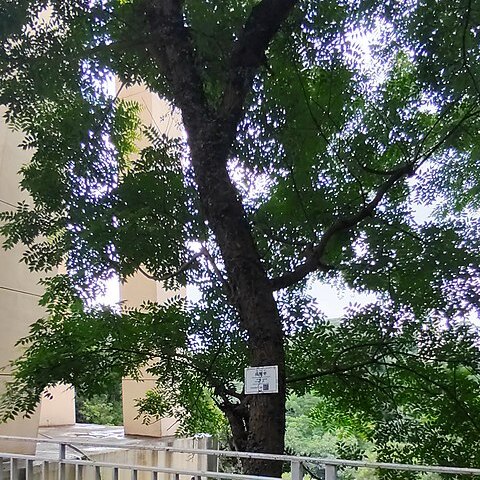Deciduous trees, 8-20 m tall; branchlets dark purplish brown, minutely pubescent to glabrous, lenticellate. Petiole inflated at base, petiole and rachis minutely pubescent to glabrous; leaf blade 25-40 cm, imparipinnately compound, with 3-6 leaflets; leaflet petiolule slender, 2-5 mm, glabrous to minutely pubescent; leaflet blade ovate to ovate-lanceolate or oblong-ovate, 4-12 × 2-4.5 cm, papery, glabrous or abaxially with tufts of hair in vein axils, base ± oblique, broadly cuneate to rounded, entire or serrate at base, apex long acuminate, lateral veins 8-10 pairs, prominent on both surfaces, reticulate venation obscure. Male inflorescence 4-10 cm, minutely pubescent to glabrous; floral subtending bracts minute. Male flowers: calyx minutely pubescent to glabrous, lobes triangular, ca. 1 mm, apically obtuse, with purplish red glandular-ciliate hairs along margin; petals oblong, 2.5-3 mm, with brown venation, recurved at anthesis; stamens equal to petals in length, anthers oblong, ca. 1 mm. Female flowers solitary in axils of distal leaves, larger than male flowers; ovary ca. 1.5 mm, 5-locular, style ca. 0.5 mm. Drupe ellipsoidal or obovate-ellipsoidal, yellow at maturity, 2.5-3 cm, ca. 2 cm in diam.; endocarp 2-2.5 × 1.2-1.5 cm.
More
A tree that loses its leaves. It is 15-30 m high and has a trunk 40-50 cm across. The young branches are stout. They are 5 mm across. The small branches are purple brown in colour. The leaves are alternate. They are compound made up of pairs of leaflets with one leaflet at the end. The leaves are 25-40 cm long. The leaflets are in 5-13 pairs and 10 cm long by 3-3.5 cm wide. The leaf stalk is 2 cm long. The male and female flowers occur on separate trees. The male flowers are in loose irregular arrangements either at the ends of branches or in the axils of leaves. They are 15-20 cm long. The female flowers occur singly or in 2's or 3's in the axils of leaves. The flowers are reddish-purple. The fruit is fleshy and has 5 stones inside. The fruit is 3 cm across and is yellow.
A tropical and subtropical plant. It grows in Northern Vietnam and below 600 m altitude. It is mostly on deep, wet red soils. It grows between 600-2000 m altitude in southern Yunnan. In XTBG Yunnan. In Sichuan.
More
Lowland, hill, and mountain forests at elevations of 300-2,000 metres in southern China. Usually found in secondary forests in Vietnam at elevations below 600 metres.
The ripe fruit can be eaten raw and used for wine production. The fruit are used for candy, jam and pickles. It is the half ripe fruit that are used for pickles. The fruit pulp is dried to make marmalade or jams. The young leaves are eaten raw.


